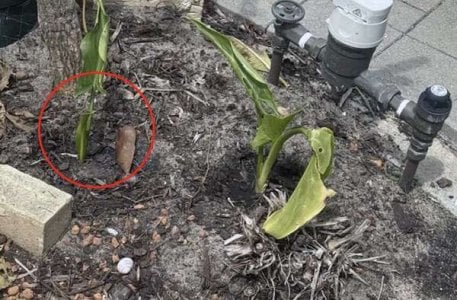Discover the Shocking Toxic Threat an Aussie Found Next Door – Should They Spill the Secret?
By
Seia Ibanez
- Replies 6
In the land down under, our backyards are often a source of pride and joy, a place where we can enjoy the unique beauty of Australia's native flora. However, the tranquility of our gardens can sometimes be disrupted by the unwelcome arrival of invasive species that pose a threat not only to our local ecosystems but also to our health.
Recently, a Western Australian man from the picturesque town of Busselton, located in the state's southwest, stumbled upon a concerning sight in his neighbor's garden. The neighbors, who had recently moved to Australia from overseas, had planted arum lilies, a species known for its elegant white flowers. The man, aware of the potential dangers, took to social media to seek advice: 'Should I go and let them know it's a no-no?'
His post quickly became a hot topic among the online community, garnering over a hundred responses from fellow gardening enthusiasts. The consensus was clear: the arum lily, while aesthetically pleasing, is an invasive and highly toxic pest that has no place in Australian gardens.
The arum lily, originally imported from South Africa, has been declared a pest in Western Australia. Its presence is not just a local issue; it's a nationwide concern. The plant's toxicity extends to all its parts, posing a serious risk to both humans and animals. A spokesperson for the WA Department of Primary Industries emphasized the dangers, stating, 'Arum lily has fleshy roots and forms extensive tubers which store food for future use. All parts of the plant are poisonous to humans and animals.'
Clare Hart, Manager Horticulture at Royal Botanic Gardens Victoria, offered practical advice for those who might encounter the plant. She urged people to wear protective clothing when handling arum lilies and to dispose of the plant parts safely, without composting, to prevent further spread.
The arum lily's impact goes beyond its toxicity. It chokes waterways, reduces pasture productivity, and outcompetes native plants. The presence of calcium oxalate in the plant can lead to severe health issues, including skin irritation, breathing difficulties, and gastrointestinal distress. In extreme cases, it can even be fatal.
So, what should you do if you spot an arum lily in your or your neighbor's garden? It's essential to approach the situation with sensitivity and care. Informing your neighbors about the risks and offering alternative plant suggestions can help protect both the environment and the community. For example, the Swamp Lily (Crinum pedunculatum) is a beautiful and safe alternative that can add charm to any garden without the associated risks.
As members of the Seniors Discount Club, we understand the importance of looking out for one another and preserving the natural beauty of our surroundings. If you've encountered similar situations or have tips on dealing with invasive species, we'd love to hear your stories. Share your experiences in the comments below, and let's continue to nurture our gardens and our communities safely and sustainably.

Remember, if you come across a story or issue that you think needs attention, don't hesitate to reach out to news outlets like Yahoo News Australia at [email protected]. Your vigilance could make a significant difference in safeguarding our cherished Australian environment.
Recently, a Western Australian man from the picturesque town of Busselton, located in the state's southwest, stumbled upon a concerning sight in his neighbor's garden. The neighbors, who had recently moved to Australia from overseas, had planted arum lilies, a species known for its elegant white flowers. The man, aware of the potential dangers, took to social media to seek advice: 'Should I go and let them know it's a no-no?'
His post quickly became a hot topic among the online community, garnering over a hundred responses from fellow gardening enthusiasts. The consensus was clear: the arum lily, while aesthetically pleasing, is an invasive and highly toxic pest that has no place in Australian gardens.
The arum lily, originally imported from South Africa, has been declared a pest in Western Australia. Its presence is not just a local issue; it's a nationwide concern. The plant's toxicity extends to all its parts, posing a serious risk to both humans and animals. A spokesperson for the WA Department of Primary Industries emphasized the dangers, stating, 'Arum lily has fleshy roots and forms extensive tubers which store food for future use. All parts of the plant are poisonous to humans and animals.'
Clare Hart, Manager Horticulture at Royal Botanic Gardens Victoria, offered practical advice for those who might encounter the plant. She urged people to wear protective clothing when handling arum lilies and to dispose of the plant parts safely, without composting, to prevent further spread.
The arum lily's impact goes beyond its toxicity. It chokes waterways, reduces pasture productivity, and outcompetes native plants. The presence of calcium oxalate in the plant can lead to severe health issues, including skin irritation, breathing difficulties, and gastrointestinal distress. In extreme cases, it can even be fatal.
So, what should you do if you spot an arum lily in your or your neighbor's garden? It's essential to approach the situation with sensitivity and care. Informing your neighbors about the risks and offering alternative plant suggestions can help protect both the environment and the community. For example, the Swamp Lily (Crinum pedunculatum) is a beautiful and safe alternative that can add charm to any garden without the associated risks.
As members of the Seniors Discount Club, we understand the importance of looking out for one another and preserving the natural beauty of our surroundings. If you've encountered similar situations or have tips on dealing with invasive species, we'd love to hear your stories. Share your experiences in the comments below, and let's continue to nurture our gardens and our communities safely and sustainably.
Key Takeaways
- A Western Australian man noticed his overseas neighbours planting arum lilies, which are an invasive and toxic pest in Australia.
- Social media users and local gardeners provided advice and expressed concern over the spread of arum lilies in native bushlands.
- Arum lilies are declared pests in WA and are poisonous to humans and animals, with all parts of the plant being toxic.
- Experts advise wearing protective clothing when handling arum lilies and recommend replacing them with native or more suitable plants for gardens.
Remember, if you come across a story or issue that you think needs attention, don't hesitate to reach out to news outlets like Yahoo News Australia at [email protected]. Your vigilance could make a significant difference in safeguarding our cherished Australian environment.








